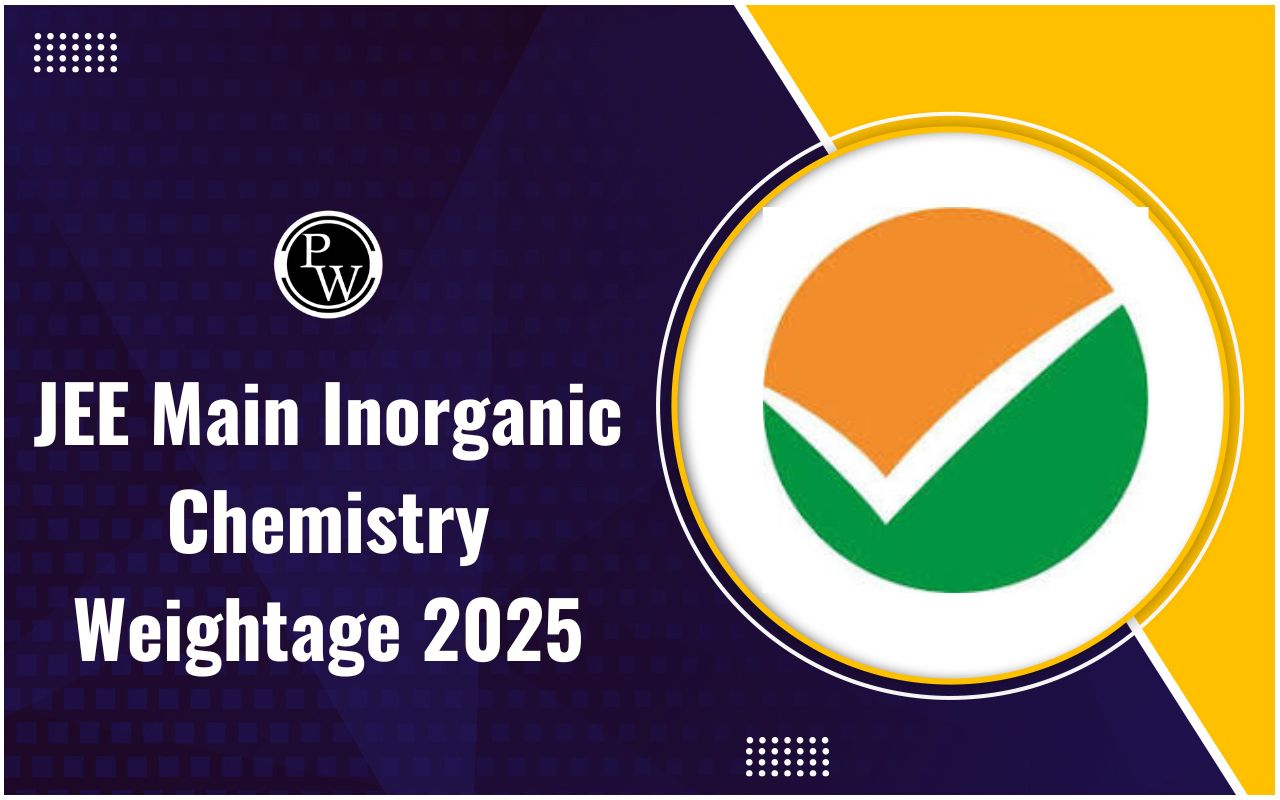

JEE Main Inorganic Chemistry Weightage 2025 : NTA is going to release JEE Main Syllabus 2025 for Physics, Chemistry, and Mathematics subjects on the official website of NTA. JEE Main Chemistry Syllabus 2025 includes three sections i.e., Section A Physical Chemistry, Section B Inorganic Chemistry, and Section C Organic Chemistry.
Candidates must know the section-wise weightage of JEE Main Chemistry Syllabus 2025 to prepare accordingly. JEE Main Inorganic Chemistry Weightage 2025 is updated in this article. JEE Main Inorganic Chemistry includes topics such as Classification of Elements and Periodicity in Properties, p-Block Elements, D and F Block Elements, and Coordination Compounds. As per the students, Inorganic Chemistry is the easiest part of JEE Main Chemistry Syllabus 2025.JEE Main Inorganic Chemistry Weightage 2025
JEE Main Inorganic Chemistry includes units namely Classification of Elements and Periodicity in Properties, p-Block Elements, d and f Block Elements, and Coordination Compounds. Candidates can check unit-wise JEE Main Inorganic Chemistry Weightage 2025 in the table below.| JEE Main Inorganic Chemistry Weightage 2025 | |
| Unit | Weightage |
| Classification of Elements and Periodicity in Properties | 1 |
| p-Block Elements | 3 |
| d and f Block Elements | 1 |
| Coordination Compounds. Candidates | 1 |
JEE Main Inorganic Chemistry Syllabus 2025
JEE Main Chemistry Syllabus 2025 includes Physical Chemistry, Inorganic Chemistry, and Organic Chemistry. Candidates can check the unit-wise included topics in JEE Main Inorganic Syllabus 2025 in the table below.| JEE Main Inorganic Chemistry Syllabus 2025 | |
| Units | Topics |
| Classification of Elements and Periodicity in Properties | Modem periodic law and present form of the periodic table, s, p. d and f block elements, periodic trends in properties of elements atomic and ionic radii, ionization enthalpy, electron gain enthalpy, valence, oxidation states and chemical reactivity. |
| P-Block Elements | Group -13 to Group 18 Elements: General Introduction: Electronic configuration and general trends in physical and chemical properties of elements across the periods and down the groups; unique behaviour of the first element in each group. Groupwise study of the p – block elements Group -13: Preparation, properties and uses of boron and aluminium; Structure, properties and uses of borax, boric acid, diborane, boron trifluoride, aluminium chloride and alums. Group -14: The tendency for catenation; Structure, properties and uses of Allotropes and oxides of carbon, silicon tetrachloride, silicates, zeolites and silicones. Group -15: Properties and uses of nitrogen and phosphorus; Allotrophic forms of phosphorus; Preparation, properties, structure and uses of ammonia, nitric acid, phosphine and phosphorus halides, (PCl3. PCl5); Structures of oxides and oxoacids of nitrogen and phosphorus. Group -16: Preparation, properties, structures and uses of ozone: Allotropic forms of sulphur; Preparation, properties, structures and uses of sulphuric acid (including its industrial preparation); Structures of oxoacids of sulphur. Group-17: Preparation, properties and uses of hydrochloric acid; Trends in the acidic nature of hydrogen halides; Structures of Interhalogen compounds and oxides and oxoacids of halogens. Group-18: Occurrence and uses of noble gases; Structures of fluorides and oxides of xenon. |
| D and F Block Elements | Transition Elements: General introduction, electronic configuration, occurrence and characteristics, general trends in properties of the first-row transition elements – physical properties, ionization enthalpy, oxidation states, atomic radii, colour, catalytic behaviour, magnetic properties, complex formation, interstitial compounds, alloy formation; Preparation, properties and uses of K2Cr2O7, and KMnO4. Inner Transition Elements Lanthanoids – Electronic configuration,oxidation states and lanthanoid contraction. Actinoids: Electronic configuration and oxidation states. |
| Coordination Compounds | Introduction to co-ordination compounds. Werner’s theory; ligands, co-ordination number, denticity. chelation; IUPAC nomenclature of mononuclear co– ordination compounds, isomerism; Bonding-Valence bond approach and basic ideas of Crystal field theory, colour and magnetic properties; Importance of co– ordination compounds (in qualitative analysis, extraction of metals and in biological systems). |
JEE Main Inorganic Chemistry Preparation Tips 2025
Candidates can follow the below-mentioned preparation tips while preparing for the JEE Main Inorganic Chemistry 2025.- Understand the Basics: Start by getting a strong grasp of the fundamental concepts like atomic structure, periodic table trends, and chemical bonding. These are the building blocks for more complex topics.
- Master the Periodic Table: Familiarize yourself with the periodic table, including the properties and trends of different groups and periods. Knowing how elements behave helps in understanding reactions and properties.
- Focus on Coordination Compounds: Pay special attention to coordination chemistry, including the nomenclature, isomerism, and bonding. Practice problems related to these concepts regularly.
- Use NCERT Textbooks: The NCERT Chemistry textbooks are highly recommended for JEE preparation. They cover the syllabus clearly and concisely and are great for building a strong foundation.
- Solve Previous Year Papers: Practice solving previous years’ JEE Main question papers to understand the pattern and type of questions asked. This will also help you manage your time during the exam.
- Regular Revision: Set a regular time for revision. Inorganic chemistry involves a lot of formulas. Revising the formulas will help you to remember the information.
Study Material For JEE 2025 Preparation
Physics Wallah offers comprehensive study material for JEE 2025 Preparation , i ncluding well-structured video lectures, detailed notes, practice questions, and test series. The material covers all JEE Main Syllabus topics, ensuring a strong conceptual understanding and effective problem-solving skills.JEE Main Inorganic Chemistry Weightage 2025 FAQs
Q.1 : What are the topics included in JEE Main Inorganic Chemistry Syllabus?
Ans. JEE Main Inorganic Chemistry includes topics such as Classification of Elements and Periodicity in Properties, p-Block Elements, D and F Block Elements, and Coordination Compounds.
Q.2 : Which unit has the highest weightage in JEE Main Inorganic Chemistry?
Ans. p-Block Elements has the highest weightage in JEE Main Organic Chemistry Syllabus 2025.
Q.3 : How many questions are asked from JEE Main Inorganic Chemistry syllabus?
Ans. Candidates can expect 5-6 questions in JEE Main 2025 question paper from JEE Main Inorganic Chemistry Syllabus 2025.
Q.4 : Is the S-block removed from JEE 2025?
Ans. Yes, the S block element chapter has been removed from JEE Main 2025 syllabus. Hydrogen, Environmental Chemistry, Alcohol Phenol, Ether, and Polymers chapters are also removed from JEE Main 2025.
Q.5 : What are the topics included in Classification of Elements and Periodicity in Properties?
Ans. Classification of Elements and Periodicity in Properties includes Modem periodic law and present form of the periodic table, s, p. d and f block elements, periodic trends in properties of elements atomic and ionic radii, ionization enthalpy, electron gain enthalpy, valence, oxidation states and chemical react
🔥 Trending Blogs
Talk to a counsellorHave doubts? Our support team will be happy to assist you!

Check out these Related Articles
Free Learning Resources
PW Books
Notes (Class 10-12)
PW Study Materials
Notes (Class 6-9)
Ncert Solutions
Govt Exams
Class 6th to 12th Online Courses
Govt Job Exams Courses
UPSC Coaching
Defence Exam Coaching
Gate Exam Coaching
Other Exams
Know about Physics Wallah
Physics Wallah is an Indian edtech platform that provides accessible & comprehensive learning experiences to students from Class 6th to postgraduate level. We also provide extensive NCERT solutions, sample paper, NEET, JEE Mains, BITSAT previous year papers & more such resources to students. Physics Wallah also caters to over 3.5 million registered students and over 78 lakh+ Youtube subscribers with 4.8 rating on its app.
We Stand Out because
We provide students with intensive courses with India’s qualified & experienced faculties & mentors. PW strives to make the learning experience comprehensive and accessible for students of all sections of society. We believe in empowering every single student who couldn't dream of a good career in engineering and medical field earlier.
Our Key Focus Areas
Physics Wallah's main focus is to make the learning experience as economical as possible for all students. With our affordable courses like Lakshya, Udaan and Arjuna and many others, we have been able to provide a platform for lakhs of aspirants. From providing Chemistry, Maths, Physics formula to giving e-books of eminent authors like RD Sharma, RS Aggarwal and Lakhmir Singh, PW focuses on every single student's need for preparation.
What Makes Us Different
Physics Wallah strives to develop a comprehensive pedagogical structure for students, where they get a state-of-the-art learning experience with study material and resources. Apart from catering students preparing for JEE Mains and NEET, PW also provides study material for each state board like Uttar Pradesh, Bihar, and others
Copyright © 2025 Physicswallah Limited All rights reserved.











